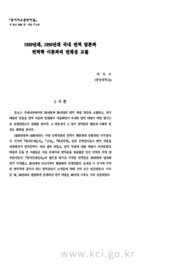

PARTNER
검증된 파트너 제휴사 자료
1920년대, 1930년대 국내 번역 담론과 번역학 이론과의 연계성 고찰 (A Study of the Relationship between Translation Discourse of 1920s and 1930s in Korea and Translation Theories)
34 페이지
최초등록일 2025.03.28
최종저작일
2009.06

-
미리보기
서지정보
· 발행기관 : 한국동서비교문학학회
· 수록지 정보 : 동서비교문학저널 / 20호 / 77 ~ 110페이지
· 저자명 : 박옥수
초록
1920s and 1930s were the times when translations were produced using modern methods and regarded as a type of literature in Korea. During this period, translations of foreign literature were introduced and translation criticism was performed in earnest. The fact that the translations were practiced through direct translation from source texts’ language is meaningful from the viewpoint of criticism. It means that the translated works became the objects of criticism for the first time. The noticeable thing is that the discourses of criticism in those days involved the developmental process and contents of translation theories. It has been revealed that the translation strategies are various since translation theories reflect the translation practice and develop on the basis of translation phenomena.
This paper examines the standpoint of criticism in those times and correlates the contents of criticism with translation theories. The aspects of translations and translation strategies are naturally revealed and discussed in the process.
Criticism in Korea started with linguistic issues and developed into the culture and text level. Then it proceeded into Descriptive Translation Studies dealing with the social and literary status of translation works. The arguing points of criticism in 1920s are literal or free translation, literary style, and expression of translating words while those in 1930s were extended and discussed the status of translation studies, selection of source texts, and general presence of translation works within the society. In brief, criticism of 1920s performed from a linguistic point of view while that of 1930s referred the relationship between the translation, and social and literary system in the society.영어초록
1920s and 1930s were the times when translations were produced using modern methods and regarded as a type of literature in Korea. During this period, translations of foreign literature were introduced and translation criticism was performed in earnest. The fact that the translations were practiced through direct translation from source texts’ language is meaningful from the viewpoint of criticism. It means that the translated works became the objects of criticism for the first time. The noticeable thing is that the discourses of criticism in those days involved the developmental process and contents of translation theories. It has been revealed that the translation strategies are various since translation theories reflect the translation practice and develop on the basis of translation phenomena.
This paper examines the standpoint of criticism in those times and correlates the contents of criticism with translation theories. The aspects of translations and translation strategies are naturally revealed and discussed in the process.
Criticism in Korea started with linguistic issues and developed into the culture and text level. Then it proceeded into Descriptive Translation Studies dealing with the social and literary status of translation works. The arguing points of criticism in 1920s are literal or free translation, literary style, and expression of translating words while those in 1930s were extended and discussed the status of translation studies, selection of source texts, and general presence of translation works within the society. In brief, criticism of 1920s performed from a linguistic point of view while that of 1930s referred the relationship between the translation, and social and literary system in the society.참고자료
· 없음태그
-
자주묻는질문의 답변을 확인해 주세요

꼭 알아주세요
-
자료의 정보 및 내용의 진실성에 대하여 해피캠퍼스는 보증하지 않으며, 해당 정보 및 게시물 저작권과 기타 법적 책임은 자료 등록자에게 있습니다.
자료 및 게시물 내용의 불법적 이용, 무단 전재∙배포는 금지되어 있습니다.
저작권침해, 명예훼손 등 분쟁 요소 발견 시 고객센터의 저작권침해 신고센터를 이용해 주시기 바랍니다. -
해피캠퍼스는 구매자와 판매자 모두가 만족하는 서비스가 되도록 노력하고 있으며, 아래의 4가지 자료환불 조건을 꼭 확인해주시기 바랍니다.
파일오류 중복자료 저작권 없음 설명과 실제 내용 불일치 파일의 다운로드가 제대로 되지 않거나 파일형식에 맞는 프로그램으로 정상 작동하지 않는 경우 다른 자료와 70% 이상 내용이 일치하는 경우 (중복임을 확인할 수 있는 근거 필요함) 인터넷의 다른 사이트, 연구기관, 학교, 서적 등의 자료를 도용한 경우 자료의 설명과 실제 자료의 내용이 일치하지 않는 경우
“동서비교문학저널”의 다른 논문도 확인해 보세요!
-
마음은 흐른다: 윌리엄 제임스 심리학과 불교사상의 만남 25 페이지
According to William James’ theory, the pure experience is the basic states of life at large like the blooming and buzzing confusion. Because the range of experience spreads as it, James’ conception o.. -
『번역』과 『풀속깊이』를 통해 본 포스트콜로니얼적 문화실천 비교 연구 24 페이지
Translations became a classic and the central text in Friel’s oeuvre for a number of reasons. With its experimental representation of Irish in English, the play revives and renews the old Gaelic cultu.. -
트랜스젠더리즘과 불교의 ‘성(별)공성’ 28 페이지
The deterministic idea of sex/gender addresses that humans’ sex/gender is dichotomous and fixed. All humans are either a male(a being of masculinity) or a female(a being of femininity), and their sex/.. -
깨달음에 대한 태도로 본 한국불교의 세계화 22 페이지
Korean Buddhism has been unknown to the world due to, maybe ironically, its strong points: the indigenous Seon (Zen) characteristics. Being influenced by Taoism, Dharma’s ineffability has put invincib.. -
조선 개화기의 옥시덴탈리즘에 대한 소고 24 페이지
This study examines the Occidentalism in the late-19th-century Korea and compares it with Orientalism which is defined by Edward Said. Here, Korea’s Occidentalism refers to all the discourses and prac..
문서 초안을 생성해주는 EasyAI
